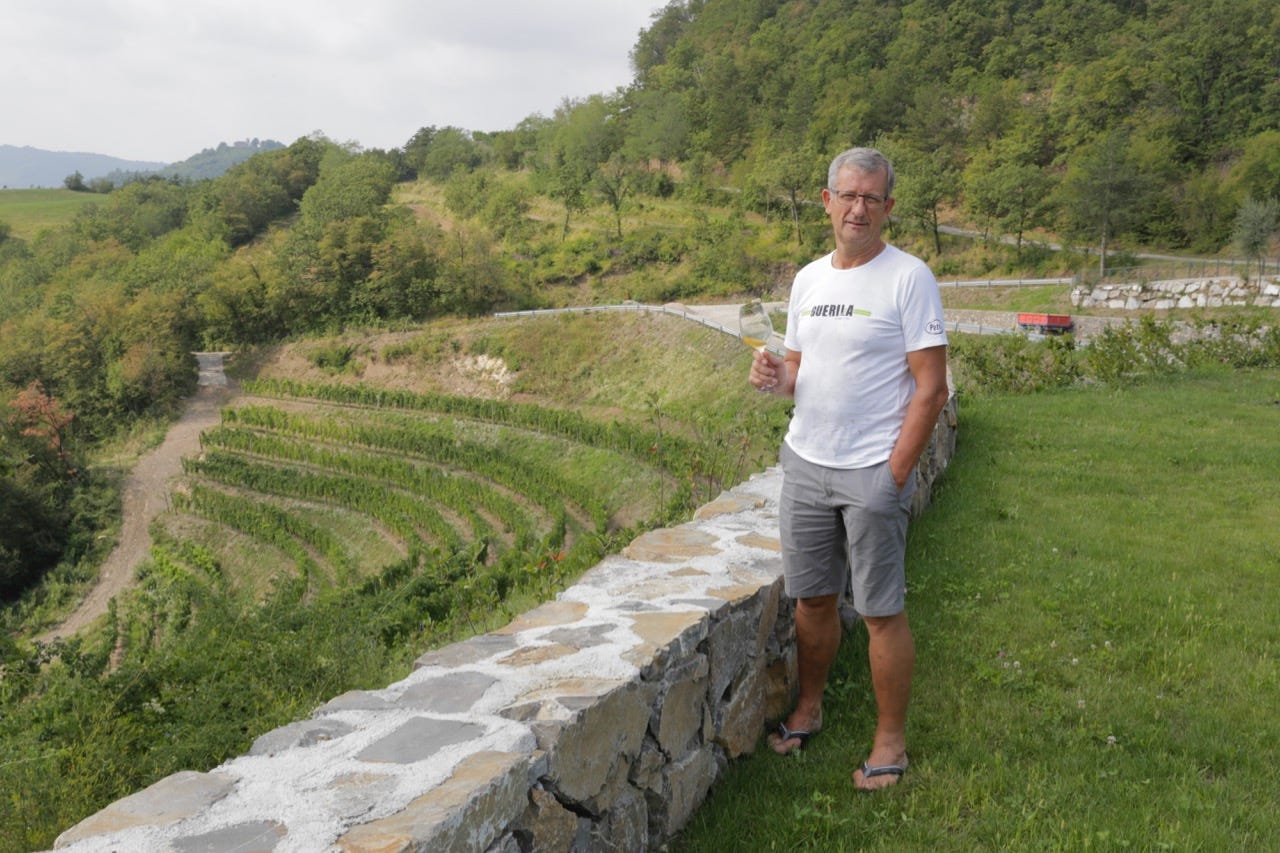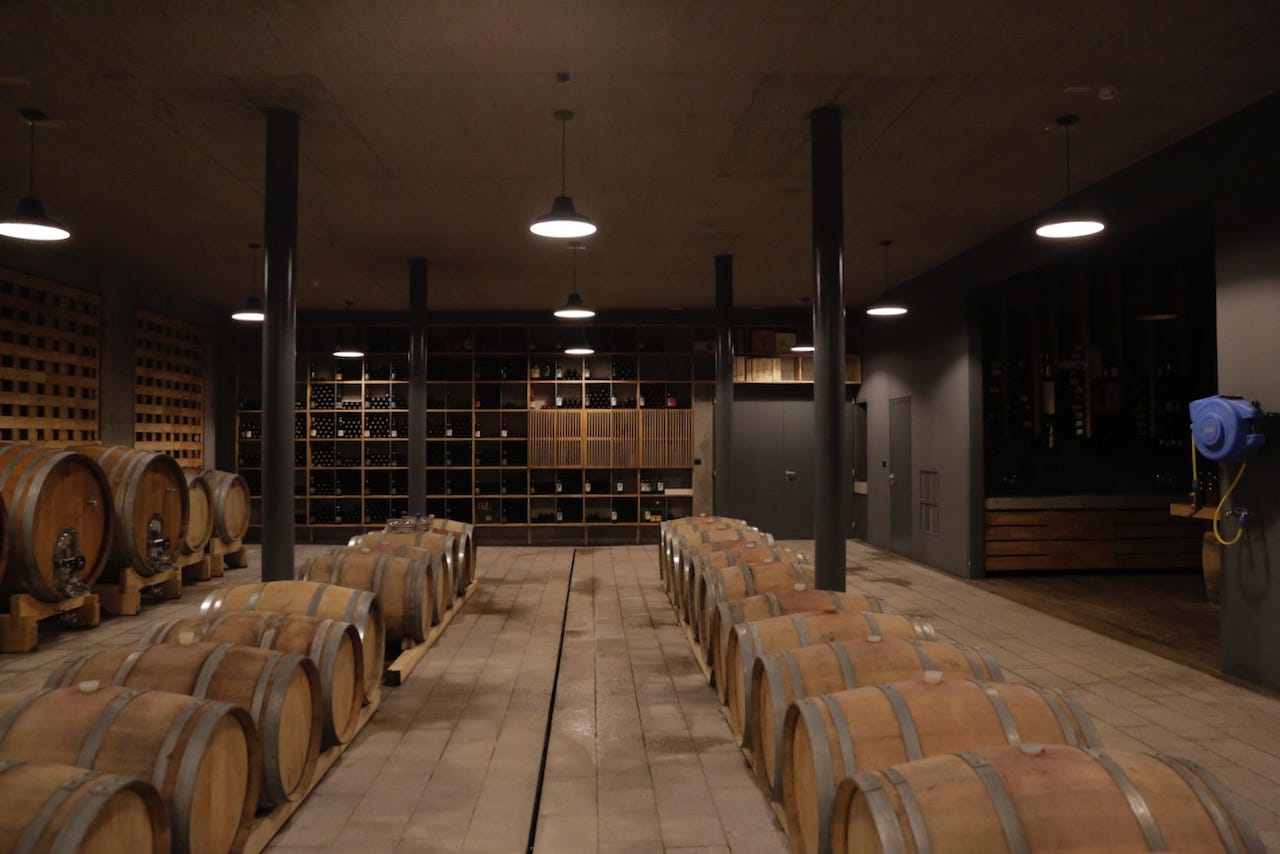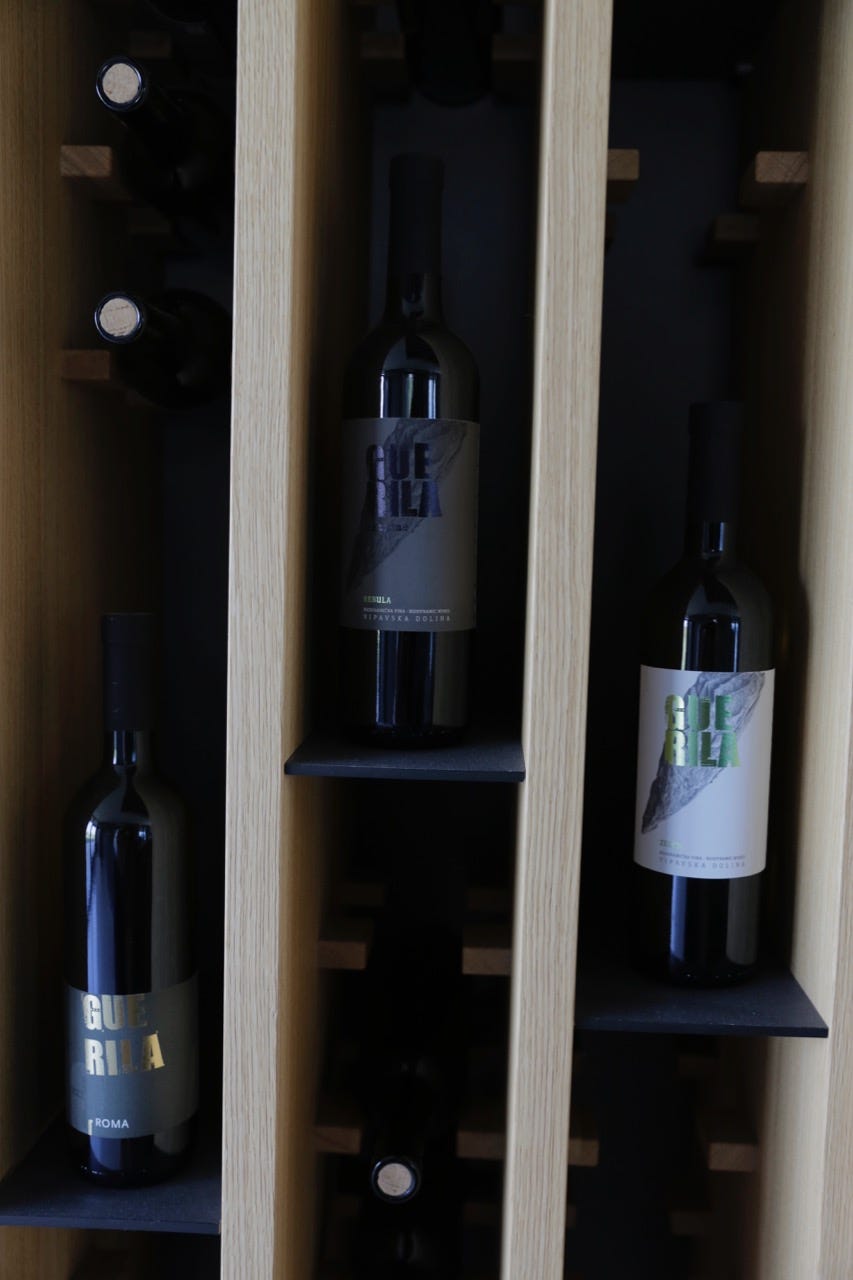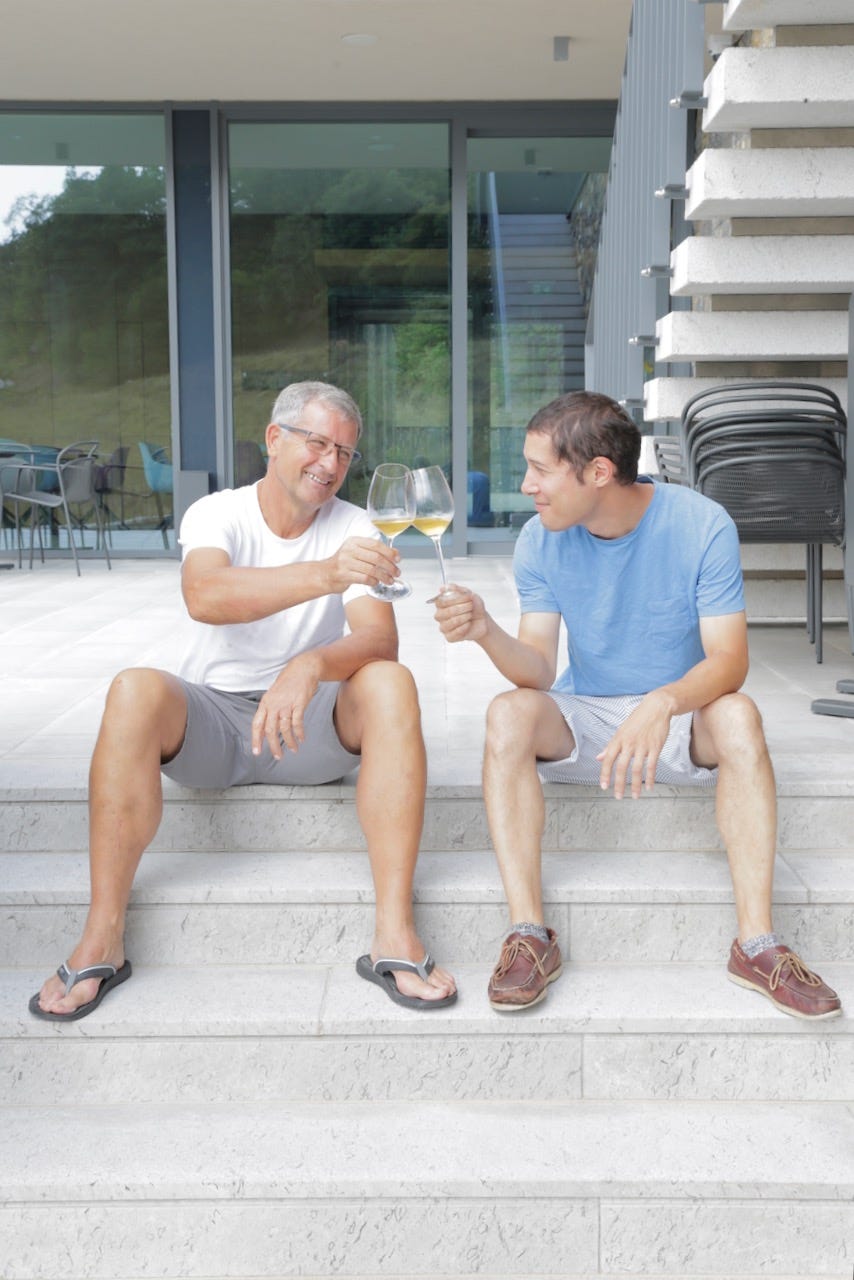SLOVENIA - Guerila Wines, Planina
Zmago Petric has both the willingness and the means to indulge a tinkering, experimental spirit.
The Native Companion and I arrive at our lodgings at Guerila Wines' new cellar facility in the hilltop village of Planina in the dead of night, after everyone has gone to sleep. It isn't until I wake for my tasting with owner Zmago Petrič the following morning that I become aware of the luxury of the surroundings: our rather chic room above the cellar overlooks the Vipava valley and Petrič's cascading south-facing terraces of malvasia, barbera, and picolit. The cellar's entry-level ground floor boasts a bar with an espresso machine, numerous tasting tables, and a conference room.
Petrič is in his early sixties, a mechanical technician by training, with silver executive hair. Despite possessing a good command of English, he speaks like someone slightly abashed by the handicap of a second language. I'll soon discover he is a peculiar case: a wealthy businessman who has embraced most of the trappings of New World-style marketing in the presentation of his estate, but who puts them in service of biodynamic farming and genuinely thoughtful natural winemaking.
Sulfite use is restrained (most final analyses between 25-50mg/l total) and all the macerated wines wines that see élévage are bottled without filtration, as are his sparkling wines. What's in the Guerila Wine bottles is far better than what their labels - and the forthrightly commercial ultra-modern cellar space - might lead one to expect.
Petrič explains that the winery's notably non-Slovenian name is a reference to the struggle required to work in revolutionary ways. In his case, the customary route of naming a winery after oneself was perhaps complicated by the fact that he already founded a company in 1992 named after himself: Petrič d.o.o., a metal construction business that saw success working on Ljubljana's World Trade Center and various highways around the nation. Petrič founded Guerila in 2005, but had been tending family vines for years as a hobby, winemaking having been in his family for generations.
Like that of his friend and neighbour Primož Lavrenčič, Petrič's cellar is built into a hillside, a vertical construction that permits avoidance of pumping at many stages. Harvest is vatted by gravity, and ferments in steel or concrete tank, depending on the cuvée. "This year we bought tanks with temperature control," he mentions, vis-à-vis his pinela, saying it's necessary for longer macerations. "Without temperature control , the temperature rises very fast, and then we must press."
One could organize street hockey games in the free space on the vinification floor. It's enormous. "I was afraid the first year, because we do spontaneous fermentation, and the yeast is not in the walls, in the pipes, and the concrete here," Petrič says. "But we didn’t have any problems."
In the barrel cellar below, a wooden latticework wall opens to reveal a dead-end tunnel carved 22m into the adjacent moisture-slick bedrock for purposes of ageing sparkling wine.
For his cuvées that see longer maceration, Petrič employs a mixture of barriques and demi-muids, although in the future he plans to focus on the latter. "Because I like the fruit smell, the grape smell, not the oak smell," he explains.
His vines at Guerila Wine are relatively young, planted for the project since the early 2000's across five south-facing, steeply-terraced vineyard sites, all sited on variations of the local lapor (flysch) soil. The range of wines he produces is divided between three ascending categories, in the manner of airline tickets: "Guerila Classic," "Guerila Selection" and "Guerila Extreme."
It's probably unwise for wine producers to imply a clear hierarchy in the very names of their wines, for it discourages consumers from finding their own favourites. Who's to say a long-macerated "Extreme" wine is necessarily greater or grander than an almost unmacerated "Classic" wine? And isn't it counterproductive, for a producer of orange wines to self-consciously 'other' the age-old category of orange wines by calling it "Extreme"? And shouldn't the word "Retro," which titles Petrič's mixed-varietal wines, be reserved for the use of parents, when their teenage children discover thrift stores?
Among my greatest frustrations in life is the knowledge that the people who advise such branding decisions almost certainly make far more money than me.
Branding aside, the Guerila Wines themselves are excellent, particularly taking into account the youth of the vineyards. Petrič's work with malvasia particularly stands out throughout all three of the Guerila Wine ranges. Even as a barely-macerated "Classic" varietal wine, the malvasia shows depth and a nuanced, ripe-nectarine profile. The local pinela grape also wears this barely-macerated style well, scanning like a fragrant Balkan vinho verde.
Petrič's rebula wines, on the other hand, seem to demonstrate the wisdom of long macerations for this thick-skinned grape. The "Selection" rebula, macerated for just 3 days, emphasizes the grape's more muted, rindy, shell-like aspects, whereas the "Extreme" version, macerated for 45 days, unfurls its exotically spiced, ripe tamarind notes in all their unctuous glory.
The "Retro" red, a cofermented blend of merlot, barbera, and cabernet franc, incarnates a massive, savage style of red that has become anachronistic and slightly rare in the natural wine world. A whiff of volatility adds agility to a wine that might otherwise move like a mudslide on the palate.
Due to scheduling constraints, Petrič and I taste through his wines in three short sessions over the course of two days. On the morning we depart he opens two unlabeled bottles. The first is an undisgorged pétillant-naturel from chardonnay. I've already enjoyed his "Castra Brut Rosé," a dry yet full-fruited direct-press merlot-cabernet crémant he produces using frozen must to induce secondary fermentation. This chardonnay is something else: leesy, electric, fatless, with a brisk kumquat fruit. Petrič soon reveals it is a 2009 that has spent almost a decade on its lees.
For a parting toast he opens an experimental bottle of malvasia from 2015, a wine which macerated and fermented in barrel without topping-up. For me it is another confirmation of the grace of his malvasia: an opulent, lightly waxen, roast-pineapple profile, lacking no acid from its time in contact with air.
Both wines are unsulfured. Above all, they're convincing: both in their individual quality - immense ! - and in how they testify to a questing, tinkering, experimental spirit, one which Petric has both the willingness and the means to indulge.
GUERILA Wines - Zmago Petrič
Planina 111
5270 Ajdovščina
Slovenia
Tel: +386 51 660 265
FURTHER READING
An April 2019 interview with Guerila's commercial director, Martin Gruzovin, at Grape Collective.
Simon Woolf has a good pic of the tunnel at Guerila in this tweet from 2018. Quentin Sadler provides tasting notes on some earlier vintages of Guerila in his 2016 round-up of Slovenian experiences. Bob Ramsak profiles Guerila in his 2018 piece on Vipava winemakers; the piece is notable for containing a telling quote from Zmago Petrič about the winery's name: "It's hard to give a name [to a product] in these times."







